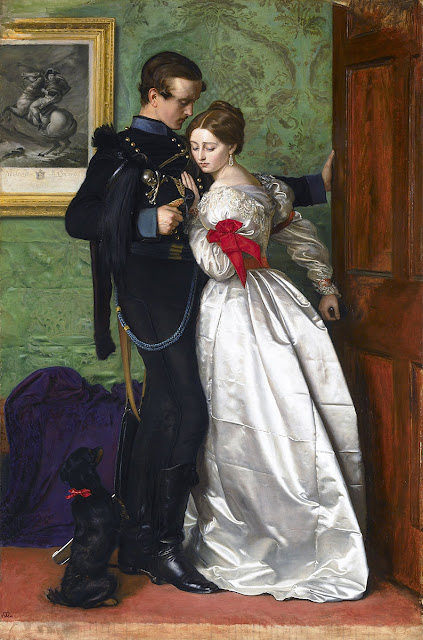The Black Brunswicker by John Everett Millais (Interpretation and Analysis)
 |
| The Black Brunswicker Source: Wikimedia Commons |
The piece depicts a young soldier and his sweetheart saying their goodbyes as he prepares to depart for battle. The title of the painting refers to the Black Brunswickers, a corp of German soldiers who became famous for bravery and sacrifice at the Battle of Waterloo. In the painting, The soldier pulls the door open, trying to leave, while the woman pushes it shut. A framed picture of Napoleon hangs in the background, illuminating the source of their conflict. The painting highlights the pain of separation. Almost all the Brunswickers were killed during the battle, suggesting that the couple in the painting might be parting for the final time.
It is an emotional scene that is accentuated by Millais’ use of color. The soldier’s black uniform contrasts strongly with the lady’s white ballgown. Not only do the two colors draw the viewer’s eye and create visual interest, they highlight the ongoing conflict between the two lovers. You can look at the painting as a Victorian version of the Yin and Yang symbol. The two lovers are opposites: the woman represents peace, and the man represents war. However, their romantic connection creates a balance between these two contradictory forces.
The couple’s tender goodbye quickly captured the imagination of the Victorian public, and the image became an instant success. Millais himself was also very proud of piece. He clearly enjoyed painting young lovers in dramatic circumstances. He reprised the theme in The Escape of a Heretic, Speak! Speak!, and A Huguenot on St. Bartholomew's Day. In fact, Millais himself even noted that The Black Brunswicker would be a good pendant to A Huguenot on St. Bartholomew's Day.
Although The Black Brunswicker is one of Millais’ most famous works, the woman in the white gown might be more famous than the painting itself. Katey Dickens, daughter of the famous English novelist Charles Dickens, posed for the lady in The Black Brunswicker.
According to my research, Dickens was a twenty-year-old art student at the time she modeled for the painting. Over the years, Millais developed a friendship with Dickens, and he painted her portrait again in 1874. By this time, Dickens was also an accomplished painter in her own right. Working under the name Kate Perugini (her married name), she became a celebrity artist. Although her art has largely been forgotten, her work was in high demand during her own lifetime. Her portraits of children were especially popular.
Katey Dickens’ life story is fascinating, but The Black Brunswicker has a unique and compelling story of its own. The painting was very popular with Victorian audiences, and its dramatic style and backstory continue to intrigue art lovers today.



Comments
Post a Comment